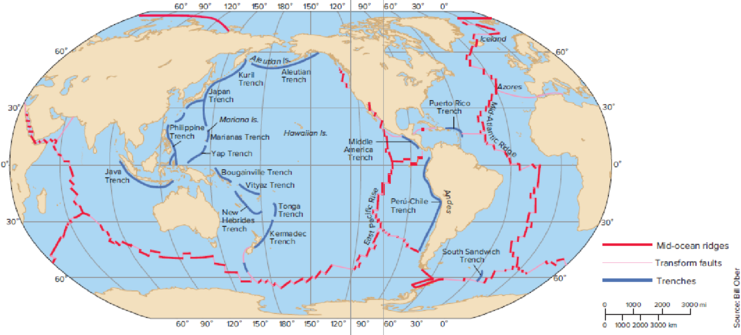
Plate tectonics works today in the same way as in the past. Can you project the future positions of the continents by looking at a map of their present positions and the positions of the mid-ocean ridges (see Fig. 2.5)? Which oceans are growing and which are shrinking? Where will new oceans form?
FIGURE 2.5 The major features of the sea floor. Compare this map with Figure 2.6.

To predict: The future positions of the continents by looking at the map of their present positions and the positions of the mid-ocean ridges.
Introduction: The continents in the earth’s crust or plates that float on the mantle portion of the Earth are called plate tectonics. The movement of plate causes formation of the mountain and continents over a millions of years that result in the geographical changes of the Earth.
Explanation of Solution
Plate tectonics are the lithospheric plates composed of continental and oceanic lithosphere. Refer to Fig. 2.5, “The major features of the sea floor”, in the text book. The future positions of the continents are given in Table 1.
Tabular representation: The following table shows the future positions of the continents.
Table 1: The future positions of the continents
| Continents | Future positions |
| North and South America | Farther west toward the Pacific Ocean |
| Europe and Asia | Farther southeast |
| Australia | Farther northeast |
| Africa | Farther east |
To determine: The oceans that are growing and shrinking.
Introduction: The continents in the earth’s crust or plates that float on the mantle portion of the Earth are called plate tectonics. The movement of plate causes formation of the mountain and continents over a millions of years, which result in the geographical changes of the Earth.
Explanation of Solution
Plate tectonics are the lithospheric plates composed of continental and oceanic lithosphere. Refer to Fig. 2.5, “The major features of the sea floor”, in the text book. The shrinking ocean is Pacific Ocean (expected to be narrower) and the growing ocean is Atlantic Ocean (expected to be wider).
To determine: Where will the new oceans form.
Introduction: The continents in the earth’s crust or plates that float on the mantle portion of the Earth are called Plate tectonics. The movement of plate causes formation of the mountain and continents over a millions of years, which result in the geographical changes of the Earth.
Explanation of Solution
Refer to Fig. 2.5, “The major features of the sea floor”, in the text book. The edges of several plates are formed by the mid-ocean ridges. At this point, the lithospheric plates move apart to form the new oceanic lithosphere (new sea floor). If the plate contains a block of continental crust, the plate moves away from the ridge, and the continent is carried along with the plate.
Want to see more full solutions like this?
- The _______________ is open ocean from the shoreline to a depth of 200 m. (a) benthic environment (b) intertidal zone (c) neritic province (d) oceanic province (e) aphotic regionarrow_forwardPlate tectonics can contribute to a. volcanoes and earthquakes. b. formation of supercontinents. c. increased weathering and CO2 sequestration.arrow_forwardThe flow of magma directly applies force to which of these crustal features? mountain ranges mountain ranges tectonic plates tectonic plates oceans oceans glaciersarrow_forward
- Which of these geologic features are sites where magma ruptures from tectonic plates? Trenches Hotspots Oceanic ridges Faultsarrow_forwardThe Permian extinction, which was the second most recent mass extinction, occurred about 251 million years ago. What is the leading hypothesis to explain the Permian extenction? An asteroid about 6 km in diameter collided with Earth, which vaporized the caribbean ocean, set fire to north and south America, and expelled enough dust into the atmosphere to block the sun enough to result in a winter like environment all across the globe for several years The Indian sub-continent collided with the Asian techtonic plate, giving rise to the Hymalayan mountains which altered the jet stream and caused the planet to enter an ice age Massive amounts of volcanic activity released tons of CO2, enough to significantly increase the temperature of the planet A new group of predators evolved that were significantly better at capturing prey, to the point that they drove many species (including other predators and eventually themselves) to extinctionarrow_forwardwhat geological process generates the worlds largest undersea mountain chain the mid Atlantic ridgearrow_forward
- Climate is the result of a variety of global processes. What of the following is a climatological driver? rotation of Earth hydrosphere properties oceanic currents concertation of sun irradiances all of the abovearrow_forwardExplain how plate tectonics cause earth tremorsarrow_forwardWhy are sedimentary rocks so common on the surface of the continents?arrow_forward
 Biology Today and Tomorrow without Physiology (Mi...BiologyISBN:9781305117396Author:Cecie Starr, Christine Evers, Lisa StarrPublisher:Cengage Learning
Biology Today and Tomorrow without Physiology (Mi...BiologyISBN:9781305117396Author:Cecie Starr, Christine Evers, Lisa StarrPublisher:Cengage Learning Biology (MindTap Course List)BiologyISBN:9781337392938Author:Eldra Solomon, Charles Martin, Diana W. Martin, Linda R. BergPublisher:Cengage Learning
Biology (MindTap Course List)BiologyISBN:9781337392938Author:Eldra Solomon, Charles Martin, Diana W. Martin, Linda R. BergPublisher:Cengage Learning


